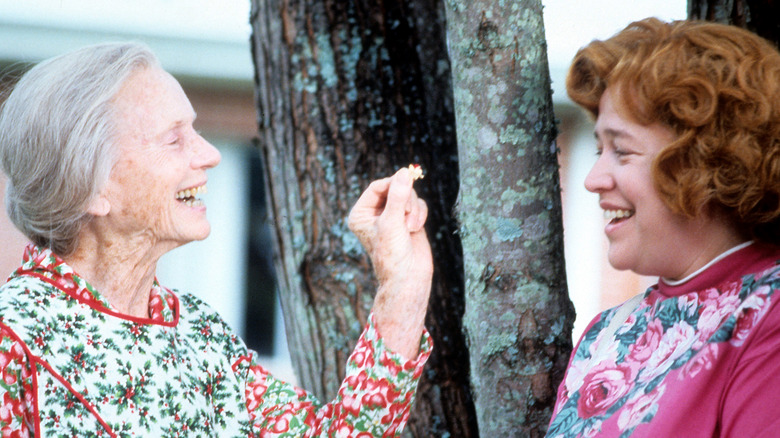The Origin Of Fried Green Tomatoes Is Not What You Might Think
There may not be a more iconically American cuisine than Southern food. Fry everything in butter, and you can't go wrong (even if your arteries might disagree). There's a reason "fried chicken" around the world often means the kind that comes from below the Mason-Dixon line. And that's not even getting into barbecue, not to mention side dishes such as hush puppies, cornbread, and fried green tomatoes. Consisting of unripe green tomatoes covered in cornmeal and fried and typically served with some sort of remoulade, you can find the latter on pretty much any Southern menu.
Here's the thing, though — fried green tomatoes aren't from the American South at all. They're from the North and the Midwest, and if you've ever enjoyed a plate of them, you can thank what might be the group you'd least expect for this dish: Jewish immigrants.
To be fair, Jewish immigrants have had an outsized impact on American culinary history (just look at the ubiquitousness of the bagel). But fried green tomatoes? This is like learning brisket, the BBQ staple, is originally Jewish ... which it is, as it came from Czech and German Jewish immigrants in the 19th century. So, maybe this isn't the only time something like this has happened.
Fried green tomatoes are an American Jewish culinary invention
The first appearances scholars can find for "fried green tomatoes" comes from two Jewish-American cookbooks published in 1889 and 1919. There are also recipes for "fried tomatoes" in Midwestern cookbooks from the 1870s — but those don't specify green tomatoes. So how did the dish come to be associated with Southern cuisine? Popular media.
The reason we think of the dish as being Southern (and let's be fair, the reason it now is Southern) is because of "Fried Green Tomatoes," the 1991 movie based on author Fannie Flagg's 1987 book "Fried Green Tomatoes and the Whistle Stop Cafe." The titular cafe in Flagg's book is based on the real-life Irondale Cafe in Irondale, Alabama, whose existence dates from 1932 and which is known for its fried green tomatoes. But the dish didn't become broadly popular in the South until after the movie's widespread success. And even if Irondale was serving the dish in the 1930s, it clearly showed up decades before then.
As far as how it got from the North to Irondale ... well, we're not sure. The most likely explanation is that the cook at Irondale was serving a recipe they'd picked up from a cookbook or a newspaper article from up north. There's evidence the dish existed in the South before then.
This is far from the only food whose origin isn't where you might expect
Lots of foods come from places you might not expect. The reuben (another Jewish culinary creation) was concocted in Omaha, Nebraska. A lot of dishes Americans eat in Chinese restaurants — General Tso's chicken, sesame chicken, crab rangoon — are American creations you can't find anywhere in China (although interestingly, egg foo young is authentically Chinese). And fortune cookies are originally from Japan. Chicken tikka masala was created in Great Britain (either in London or Glasgow), not India.
Moreover, fried green tomatoes isn't even the only "Southern" dish that isn't from the South. Chicken and waffles (which, it must be said, the South vehemently denies) were created either in Harlem or Pennsylvania. Mac and cheese came from Thomas Jefferson's time as ambassador to France. Pimento cheese, known as the "caviar of the South," is from upstate New York.
The takeaway here is that foods come from all sorts of places you might not expect. Still, even if dishes didn't originate in one location, it's perfectly normal for that locale to adopt them as its own.


